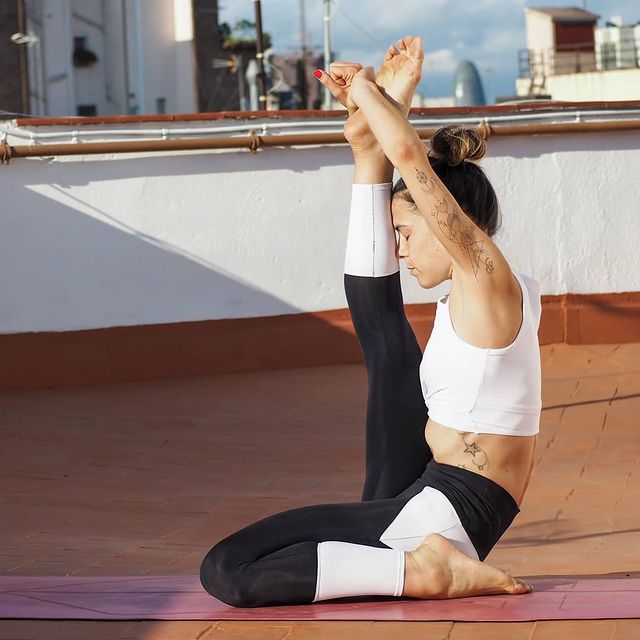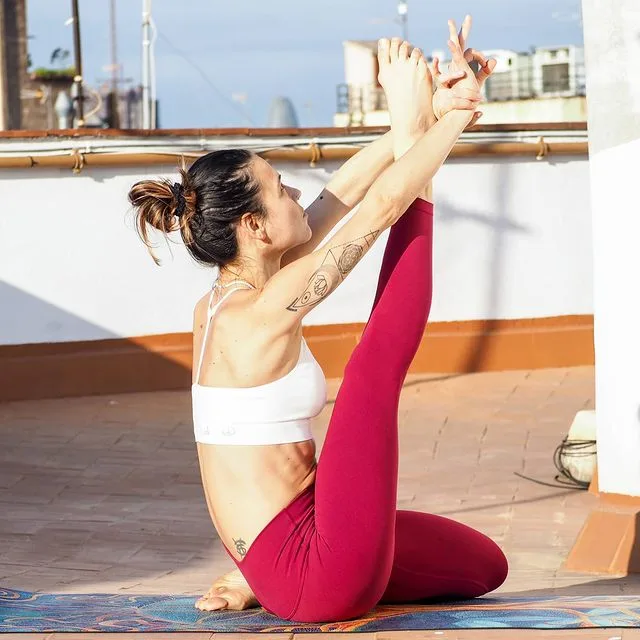Krounchasana, also known as Heron Pose, opens the hips while intensely stretching the hamstrings.
Experts believe that it can provide relief to treat flat feet and gas.
Krounchasana (Heron Pose) can be performed as a continuation of Triang Mukhaikapada Paschimottanasana. It is difficult to do as compared to Paschimottanasana and hence its effects are greater. It gives full extension to the leg and exercises the leg muscles. The abdominal organs are also rejuvenated.
Information
| Known as: | Krounchasana, Heron Pose, Kraunchasana |
| Sanskrit name: | क्रौञ्चासन |
| IAST: | Krauñcāsana |
| Pronunciation: | crown-CHAHS-ah-nuh |
| Level: | Intermediate |
| Type: | Seated, Forward-Bend, Hip opener |
| Total time: | 30 to 60 seconds |
| Drishti: | Forward; At big toe |
| Chakra: | Manipura Chakra |
| Focus: | Legs (Hips) |
| Indications: | Gas, flat feet |
| Counterpose: | Dandasana (Staff Pose) |
| Preparatory poses: | Downward Dog Pose, Hero Pose, Butterfly Pose, Dandasana, Head-to-Knee Pose, Seated Forward Bend Pose, Decent Pose, Reclining Hand to Big Toe Pose, Uttanasana, Utthita Parsvottanasana |
| Follow-up poses: | Marichyasana I, Upavistha Konasana, Paschimottanasana |
| Contraindications: | Knee injury, ankle injury, hip injury (use a folded blanket under hip for support), insomnia, asthma, Pregnancy (after the first trimester) |
Meaning + Origin
The Krounchasana is derived from the Sanskrit name, which is made up of two words — Kraunch + asana:
- “Kraunch” = “heron”
- “asana” = “pose or posture or seat”
It is also the name of a mountain, said to be the grandson of the Himalaya and pierced by Kartikeya, the god of war and Parashurama, the sixth incarnation of Vishnu.
Origin viewpoint says that once there was a war between Lord Kartikeya and the demon Tarakasura. Mount Krauncha supports Tarakasura despite his evil deeds to prove his friendship. It enraged Kartikeya and he pierced Krauncha in anger. The biased (asymmetric) decision of Mount Kraucha caused it to lose its integrity. It shows the importance of finding a balance and analysing between right and wrong when making a move.
The story is similar to Krounchasana, as this pose is about finding balance or stability while experiencing a disproportionate stretch in the legs. Also, the leg outstretched in Kraunchasana looks like a precipitate, hence it is associated with the name Krauncha Parvat (Mount).
In this seated position, one leg is bent back at the knee and the foot is placed on the side of the hip joint, while the other leg is raised vertically, its foot by the hands. Then the chin is placed on the knee of the vertical leg. The raised leg resembles a protruding neck and head of a heron, which is also a precipitate. Hence, the name.
Benefits of Krounchasana (Heron Pose)
The practice of this yoga pose can be an intermediate or an advanced exercise depending on the level of flexibility of your quadriceps, hamstrings, gluteus, hips and core muscles. At the intermediate level Krounchasana (Heron Pose) helps prepare the body for more challenging poses, and at the advanced level, Kraunchasana helps practitioners achieve greater balance and stability — maintaining a sthira sukham. However, the physical and mental benefits are listed below for reference:
- Physical Benefits:
- Stretches shoulders, chest, back, and hamstrings
- Stimulates reproductive and lymphatic system
- Relieves backache and fatigue
- Relieves menstrual and menopausal discomfort
- Improves digestion
- Improves liver, kidney, uterus, and ovary function
- Mental Benefits:
- Reduces stress
- Relives mild depression
- Relives anxiety
- Calms the mind
Krounchasana (Heron Pose) Practice Guide

Instructions
- Sit with your legs stretched out (Dandasana or Staff Pose). Bend your left leg and rest your ankle next to your hip. Keep your knees parallel. Press your hands into the floor. Root your sit bones down into the floor and lift-up through the spine.
- Bend your right knee and grab your leg with both hands. Point your left foot back, press your toes firmly into the floor, and drive your left ankle toward your hip. Pull your lower back in and up.
- Exhale and straighten your right leg up. Pull your arms back through your arms to your shoulders, and hollow out your armpits. Bring your shoulder blades to your back. Fully extend from the core of your pelvis through your right leg. Press your right thigh-bone away from your abdomen to engage the hamstring muscles. Maintain this posture for a few breaths.
- Keep pressing your right thigh away from your abdomen, exhale, and draw your right shin in toward your body as you move your torso and head. Bring your shin as close to your face as possible. Turn your elbows away from each other to draw your leg deeper.
- Stay in this position for 30 to 60 seconds. Release and repeat on the other side. Stay on both sides for equal time.
Krounchasana (Hero Pose) for Beginners
- After Step-1, bend your knee slightly and catch your leg with the belt. If you have knee pain that is on the floor, you can try sitting on a blanket or block to take some flexion off the joint. If your pain persists, come out of the pose.
- Get the feeling of lifting your leg by lifting your arms and bending your elbows. Feel how it stretches down the back of your leg. Pull your trunk toward your thigh, and try to hold it there while activating your quadriceps to straighten your knee.
- As you gain flexibility, you can reach farther and grasp your foot with your hands instead of the belt.
- Bend your elbows and draw your thigh towards the trunk. Feel how it stretches the back of your leg.
- Then activate your quadriceps to straighten your knee. This stimulates the reflex arc of reciprocal inhibition of your hamstrings, allowing them to relax into the stretch.
- Using only the leverage of your arms to straighten your leg (without contracting your quadriceps) indirectly stretches your hamstrings; However, it does not provoke mutual inhibition. That’s why you have to activate your quadriceps, which are the antagonists of your hamstrings (the muscle being stretched).
Step-by-step Anatomy Engaging Techniques
Step-1
- Contract your hamstrings to bend your knee. Squeeze your lower leg against your thigh as in Triang Mukhaikapada Paschimottanasana.
- Engagement of your hamstrings helps to maintain your knee joint as a hinge.
- Press one hand on your knee and try to lift it while resisting. It activates your psoas and its synergies of your knee flexion in a closed chain fashion and repositions your pelvis.
- Tilting the pelvis forward lengthens your hamstrings of your straight-leg by rotating your ischial tuberosity up and back.
Step-2
- Use your psoas to draw your femur into the trunk. Note that when your hips are fully bent, as in this pose, your psoas cannot generate as much additional flexion force, as it is already fully contracted.
- Activate your rectus abdominis to flex your trunk. Remember that it falls on nutrition at your sacroiliac joint: It pulls your pubic symphysis upward as your sacrum is tilts forward (with flexion of your lumbar spine).
Step-3
- Engage your quadriceps to straighten your knee. This mutually prevents your hamstrings from contracting in response to stretch — a biomechanical and physiological yin/yang in yoga. This pose also stretches your gluteus maximus of your straight-leg.
- Remember that your gluteus maximus extends and externally rotates your hip and femur. Stretching a muscle stretches its attachments and can passively produce the same motion as when your muscle is contracted. Thus, flexing your hip stretches and pulls the gluteus maximus, causing your thigh to roll into Krounchasana (Heron Pose).
- To counteract this by engaging your gluteus medius and tensor fascia lata, two muscles that internally rotate your thigh.
- The cue for activating these muscles is to try to abduct your straight-leg away from the midline while opposing it with your hand. Abduction is another action of your gluteus medius and tensor fascia lata.
- You can use this cue to elicit the internal rotation action of these muscles and counteract the outward roll of your thigh produced by the stretching of your gluteus maximus.
Step-4
- Grasp your foot to connect your upper and lower appendicular skeleton (arms and legs). Try rotating the palms upwards to lock the grip of your hands. It activates your supinator muscle. Contracting your biceps also supinates your forearms (in synergy with your brachialis) while bending the elbows.
- Flex your wrists and grasp your foot firmly; Then try to lift your arms up, engaging your anterior deltoids. Notice how it pulls the leg towards your trunk and your trunk towards your leg.
- Create a “wringing” helical effect under your arms by externally rotating your shoulders with your infraspinatus and teres minor muscles.
- Activate your lower trapezius to pull your shoulders away from your ears and lift your chest.
Precautions and contraindications
The practice of this yoga posture comes with several precautions and contraindications that must be kept in mind while practicing Krounchasana (Heron Pose). Some of the precautions and contraindications are explained below for reference:
1. Injury and surgery!
It goes without saying that individuals with any type of injury to any part of the body (muscles, ligaments, joints) should report to a yoga teacher/instructor. Since the whole body is active in this exercise like spine, ribs, abdomen, hips, shoulders, knees and ankles, any injury to any part of the mentioned part is a contraindication, and the practice of this yoga posture should be avoided.
Any old or new surgery involving any part of the body is also a contraindication, so you should take care by telling your yoga teacher/instructor about the same. Conditions such as knee injury, hip replacement surgery, diastasis recti, or even hernia, or any other abdominal surgery, all have contraindications and hence it is best to avoid practicing this yoga pose.
2. Alignment and physical strength
The practice of Krounchasana (Heron Pose) requires flexibility and strength in the hips, knees, ankles, spine and shoulders, along with helping to remain stable and in balance while holding the pose. But if you have a history of a weakened immune system, or suffer from fibromyalgia, arthritis, or any other condition that makes you feel more tired, then the practice of this yoga pose should be avoided. Simple stretches for the hips, hamstrings, and quadriceps such as Staff Pose Variation Raised One Leg Hand to Big Toe Pose or Revolved Heron Pose Variation can be included.
3. Lack of the body-breathing connection
The practice of Kraunchasana (Heron Pose) requires body-breathing coordination as well as awareness of the muscles involved to help you sit comfortably in the asana. Given this, if your awareness is lacking, or you are not yet ready for such a challenging stretch that also involves balance and stability, you should go slow and steady. Although it is not a contradiction, restlessness and lack of awareness can do more harm than good in the long run in this yoga posture.
4. Senior citizen
Given that this exercise is intense on the joints of the lower body, which also requires some flexion of the muscles, senior citizens should avoid this exercise, as they may have weak and unstable bones. Thus, in such circumstances, it is best to avoid this yoga practice, and perhaps introduce easier stretches.
4. Pregnant woman
Pregnant women will feel tremendous pressure in the lower abdomen and pelvis, making it difficult for both her and the fetus to breathe. Thus, in such circumstances, it is best to avoid this yoga practice, and perhaps introduce the easier stretche yoga poses.















